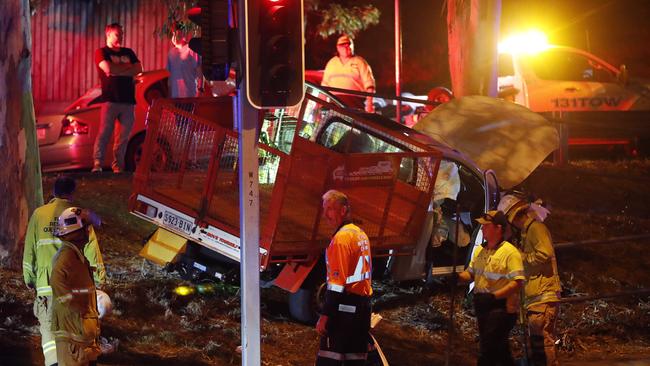Worst crash black spots in Queensland and most dangerous time to drive
Queensland’s most dangerous road has been revealed alongside the most common day when drivers are most likely to have a crash during the week.
QLD News
Don't miss out on the headlines from QLD News. Followed categories will be added to My News.
Exclusive: Motorists driving along Brisbane’s worst accident hotspot should avoid driving on Wednesday mornings, as most crashes occur between 9am and midday.
An analysis of accident insurance claims by AAMI found Gympie Rd, Chermside – a major public transport route to the CBD – is again Brisbane’s top spot for accidents
Logan Rd at Mount Gravatt was number two on the list, while Morayfield Rd at Morayfield has jumped up the rankings into position three.
Sandgate Rd at Clayfield and Waterworks Rd at Ashgrove joined the list of top 10 black spots for the first time, while the Bruce Highway at Caboolture was the worst stretch of highway.
Other roads to make the list include Ipswich Rd at Annerley, Browns Plains Rd at Browns Plains, Gympie Rd at Aspley, Logan Rd at Eight Mile Plains and Waterworks Rd, Ashgrove.
AAMI spokesman Paul Sofronoff Gympie Rd was “notorious for congestion and collisions”. “It’s a busy stretch of road which carries a high volume of traffic travelling to and from the northern suburbs and Sunshine Coast to the CBD, as well as heavier vehicles as it is a main thoroughfare,” Mr Sofronoff told News Corp Australia.
“Several other major arterial roads feed into different entry points, and there are multiple traffic lights and intersections, which can lead to extreme congestion during peak periods.”
The road was also a major bus route, which added to the potential for accidents.

Nose to tail impacts were the most common accidents on the road and Wednesday mornings between 9am and 12pm were the most dangerous times to travel.
The insurer analysed data from more than 350,000 accident insurance claims in the 12 months to June 30, which included the pandemic lockdown.
The data shows a noticeable dip in claims at the height of the national lockdown in April, but crash figures quickly returned to pre-normal levels as restrictions lifted in most states during May. Victoria’s numbers remained low as lockdown continued.
That data correlates with national road toll statistics, which show that deaths are down by almost seven per cent in the first 10 months of this year.
In April, the national road toll was down by close to 25 per cent on the same month last year, but last month it was 12 per cent higher than October 2019.
In Queensland, though, road deaths have bucked the national trend. They rose by 35 per cent in April and are up by 18.6 per cent in the first 10 months of the year.
As Australia has reopened, many people are still working from home so traffic has been lighter, but Mr Sofronoff said accidents had not dropped accordingly.
“With many of us still out of our ‘normal’ routines — working from home more and driving less, it’s easy to be lulled into a false sense of security – that because there’s less cars on the road we’re safer. But even a short trip to the shops can put us at risk of a crash if we’re not paying attention,” he said.
The data shows that nationally, Friday afternoon peak hour is the most dangerous time to be on the road.
“It’s the end of the week so people are often a bit tired and over it and focusing on the weekend,” he said
Congestion added to the danger, as more drivers were tempted to check messages and tailgating when the traffic was moving slowly.
“We see that a majority of the hot spots identified are generally busy major arterial roads that intersect with local streets. When you combine this with heavy traffic and frequent stopping, it is a perfect recipe for vehicle collisions,” Mr Sofronoff said.
Drivers needed to concentrate more in congested areas, rather than attempting to multi-task (phones were the main culprit) or becoming frustrated with other motorists.
“Tailgating is another behaviour that can lead to nose to tail collisions — especially during peak hour traffic. Maintaining a good distance between you and the car in front is one of the most effective ways of keeping yourself and others safe and allows additional time to stop if the car in front suddenly brakes.”
MORE NEWS
Grant Denyer’s plea as Aussies gear up for road trips



